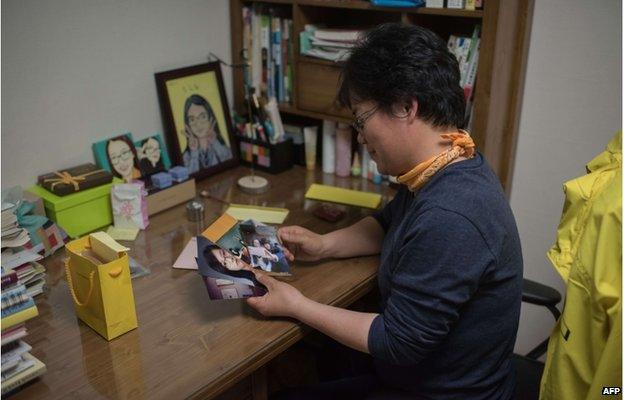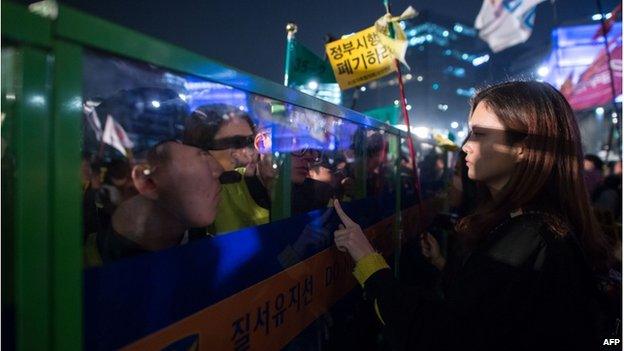Sewol ferry disaster: Demands for answers go on
- Published

Ms Lee is among several who petitioned the South Korean government to raise the sunken ferry
On 16 April 2014, a ferry capsized off South Korea's southern coast killing 304 people, mostly high school students, in one of South Korea's most high-profile maritime disasters. One year on, President Park Guen-hye has said the government will try to salvage the ship, but BBC's Stephen Evans in Seoul finds that some families are still demanding answers.
Even as President Park gave the bereaved families what they had been asking for, she must have felt their wrath and their grief.
Dressed in the black of mourning, she stood on a windy breakwater near where the Sewol sank and announced that the vessel would be raised - just as the families had demanded. "I have a heavy heart", she said, "and my heart aches to think how painful it is".
But bereaved families had left the port before she arrived, a gesture the South Korean media interpreted as a protest against what the families allege is her previous inaction over both the raising of the Sewol and fulfilling the promise of an independent enquiry.
Families had blocked access to the memorial altar by setting down a table, on which were large photographs of the nine whose remains are still unrecovered.
The families have waged a powerful campaign for the Sewol to be raised.
At a press conference they gave in Seoul the other day, the wailing of one of the mothers was uncontrollable.

Eun-hwa (far left) is among nine passengers who remain unaccounted for
She talked calmly at first of the pain of losing her bright and funny daughter but then broke down and howled in bottomless grief. The teenager had gone on a school trip full of hope and promise, but never returned and the rupture in her mother's love was unbearable.
At the same meeting, a teacher's widow told of how her husband had left and she had not been able to say goodbye. They had been married for more than thirty years, and the absence of remains impeded any healing.
Later in the quiet of her home, the mother who cried so copiously at the press conference, Lee Keum-hui and her husband, Cho Nam-sung, showed the BBC with pride photographs of Eun-hwa, the daughter whose loss had prompted the public outpouring.
The mother showed the records she still keeps on her phone of those last calls from her daughter. In those calls from the stricken vessel, Eun-hwa expressed her worry that the ship was tilting. She was concerned at the fears of her fellow passengers, her school friends from Danwon High School.
Her mother told the BBC: "It really hurts. The anger boils up. My heart feels as if it's about to burn".
And Eun-hwa's father said: "It's been unbearable having to live a whole year in grief. Ever since they stopped looking for my daughter's remains, my sadness has turned to anger against the government."
Lucy Hockings explains how the disaster unfolded
Beyond the nine families whose loved ones remain untraced, there is also a wider anger at what many of the families and their political supporters see as a failure to hold an open and truly independent enquiry.
The critics of the campaign by the families say that thorough police investigations have told us what happened: the Sewol was overloaded, it had been reconfigured unsafely so it could take more.
It had been passed as safe when it clearly and fatally was not. On top of that, the crew behaved badly, saving their own skins.
The coastguard arrived late and when it got there it didn't order the evacuation of the ship.
Survivor: "There was an announcement telling us to sit still, but the ferry was already sinking"
And individuals have been punished. For their dereliction of duty, Captain Lee Joon-seok was sentenced to 36 years in prison and 14 lower-ranking crew members received sentences of nine to 25 years.
The captain of the first coastguard vessel on the scene was jailed for four years for his negligence.
But the one man who might have been jailed got away un-jailed, albeit in bizarre circumstances.
Yoo Byung Eun, the tycoon who owned the company that ran the Sewol, fled after the accident. He was found dead in a plum field, apparently a victim of hypothermia.
But the anger in South Korea is about more than the specific failures of individuals or a system.

Protesters marking the anniversary of the disaster had stand-offs with the police in Seoul on Saturday
For the families, it is anger at the injustice of the loss of loved ones at the most hopeful point in their lives, but for the wider protest movement it is anger at what they see as an inadequate system which places too little weight on safety.
In a generation, this country has gone from ox-plough poverty to limousine affluence. The Sewol tragedy prompted many to ask how what is now such a modern country could have such inadequate regulations.
As one newspaper put it: "People wanted cheaper products and services that excluded the cost of safety."
Protesters say that lessons weren't learnt from a string of accidents, like the collapse of a department store in 1995 where 502 people died, the collapse of a bridge over the Han River in Seoul where 32 died and, just before the sinking of the Sewol, the collapse of a roof where 10 died.
When the families of the Sewol say they want an enquiry, they want the particular events of the day examined but also the broader aspects of law and regulation.
"You can't sink the truth" is their oft-repeated watch-word.
There is now a further question: will the raising of the Sewol ease the grief or remind people of the horrible events of exactly a year ago?